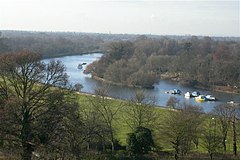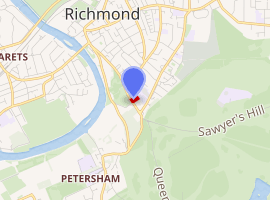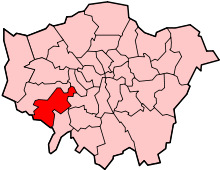Doughty House
Doughty House is a large house on Richmond Hill in Richmond, London, England, built in the 18th century, with later additions. It has fine views down over the Thames, and both the house and gallery are Grade II listed buildings.[1][2]
| Doughty House | |
|---|---|
 The view from Richmond Hill, from close to the house | |

| |
| General information | |
| Type | Residential |
| Location | Richmond Hill, Richmond upon Thames, London, England |
Listed Building – Grade II | |
| Official name | Downe House/ The Gallery at Number 142 Doughty House |
| Designated | 17 May 1999 |
| Reference no. | 1249955 (House); 1387232 (Gallery) |
The house was named after Elizabeth Doughty, who lived there from about 1786,[3] and built St Elizabeth of Portugal Church in The Vineyard, Richmond. It was the residence of the Cook baronets from when it was bought in 1849 by the first baronet until after World War II. A 125-foot-long gallery (38 m) was added in 1885 for the very important family art collection. The house was damaged by bombing in the Second World War and the 4th baronet, Sir Francis Cook, who was an artist as well as being an art collector, moved to Jersey with 30 paintings from the collection.
The first Lady Cook, the American suffragist Tennessee Claflin, was mistress of Doughty House from 1885 until her death.[4] In 1870, she became the first woman, along with her sister Victoria Woodhull, to open a Wall Street [[broker|brokerage firm].
Doughty House was sold in 2013 to the developer K10 Group Ltd., which is working on a £30 million renovation to transform the structure into a private residence by 2019.[5]
Doughty House in art
Awaiting the Arrival of Christopher at Doughty House, Richmond: Bishop and George Bellamy, March 1938 (1938) and Airing Curtains, The Garden, Doughty House, Richmond (1946) by Francis Ferdinand Maurice Cook (1907–78) are held at the Sir Francis Cook Gallery.[6][7]
See also
References
- Historic England (17 May 1999). "Doughty House (1249955)". National Heritage List for England. Retrieved 1 August 2020.
- Historic England (17 May 1999). "The Gallery at Number 142 Doughty House (1387232)". National Heritage List for England. Retrieved 1 August 2020.
- Weinreb, Ben; Hibbert, Christopher; Keay, Julia; Keay, John (1983). The London Encyclopaedia. Macmillan. p. 245. ISBN 978-1-4050-4924-5.
- House Beautiful. 9–10. Hearst Communications. 1900. p. 92. Retrieved 3 August 2020.
- Nelson, Christian (31 October 2017). "If you fancy palatial living, this prime London mansion could fit the bill". The National. Retrieved 3 August 2020.
- "Awaiting the Arrival of Christopher at Doughty House, Richmond: Bishop and George Bellamy, March 1938". Art UK. Retrieved 22 September 2016.
- "Airing Curtains, The Garden, Doughty House, Richmond". Art UK. Retrieved 22 September 2016.
